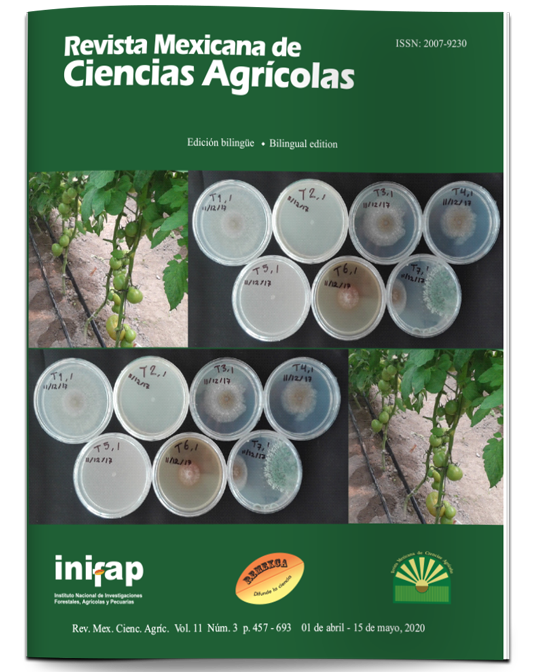Biological effect of nanoparticles loaded with microbial indoleacetic acid on tomato morphometric parameters
DOI:
https://doi.org/10.29312/remexca.v11i3.1919Keywords:
Botryodiplodia theobromae, indolacetic acid, nanoencapsulationAbstract
The tomato is one of the vegetables that have the highest production worldwide, so for its fertilization and pest control products of synthetic origin are used, which affect the ecosystem where they are applied, for this reason biologically sustainable alternatives are sought. One of these alternatives is the use of microbial metabolism, an example of this is Botryodiplodia theobromae, a phytopathogenic fungus capable of producing phytohormones from its metabolism, such as indolacetic acid (IAA). However, exogenous application of this phytohormone exhibits accelerated degradation when in contact with environmental factors. An alternative to minimize this effect is encapsulation with the use of biopolymeric materials that have the ability to coat the phytohormone and at the same time allow to increase the effectiveness of the product. In this work, the encapsulation efficiency (EE) of IAA from microbial broth was evaluated by liquid fermentation of B. theobromae in alginate/chitosan nanoparticles (Np) (ALG/QS); as well as its biological effectiveness represented in morphological development patterns in tomato plants. The results showed that IAA was produced from the microbial metabolism of Botryodiplodia theobromae, which once encapsulated reached an EE of 90%, as well as various particle sizes. Regarding the biological effectiveness in tomato plants, it was observed that the Np loaded with microbial broth and synthetic grade IAA showed a significant difference in most of the morphological parameters evaluated compared to the absolute control. Therefore, nanosystems loaded with biostimulants are shown as a future alternative for the application of biostimulants in vegetables such as tomatoes.
Downloads
Published
How to Cite
Issue
Section
License
The authors who publish in Revista Mexicana de Ciencias Agrícolas accept the following conditions:
In accordance with copyright laws, Revista Mexicana de Ciencias Agrícolas recognizes and respects the authors’ moral right and ownership of property rights which will be transferred to the journal for dissemination in open access. Invariably, all the authors have to sign a letter of transfer of property rights and of originality of the article to Instituto Nacional de Investigaciones Forestales, Agrícolas y Pecuarias (INIFAP) [National Institute of Forestry, Agricultural and Livestock Research]. The author(s) must pay a fee for the reception of articles before proceeding to editorial review.
All the texts published by Revista Mexicana de Ciencias Agrícolas —with no exception— are distributed under a Creative Commons License Attribution-NonCommercial 4.0 International (CC BY-NC 4.0), which allows third parties to use the publication as long as the work’s authorship and its first publication in this journal are mentioned.
The author(s) can enter into independent and additional contractual agreements for the nonexclusive distribution of the version of the article published in Revista Mexicana de Ciencias Agrícolas (for example include it into an institutional repository or publish it in a book) as long as it is clearly and explicitly indicated that the work was published for the first time in Revista Mexicana de Ciencias Agrícolas.
For all the above, the authors shall send the Letter-transfer of Property Rights for the first publication duly filled in and signed by the author(s). This form must be sent as a PDF file to: revista_atm@yahoo.com.mx; cienciasagricola@inifap.gob.mx; remexca2017@gmail.
This work is licensed under a Creative Commons Attribution-Noncommercial 4.0 International license.



